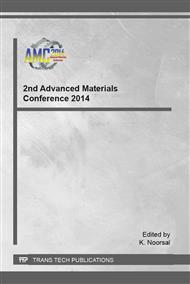p.624
p.629
p.634
p.639
p.644
p.649
p.654
p.659
p.664
The Utilization of Recycled Newspaper in the Production of Cellulose Microfiber
Abstract:
Cellulose microfibers (CMF) were produced by utilizing recycled newspaper paper (RNP) as starting material. This approach is considered as green since recycling newspaper leads to the environment preservation and also cost-effective. The effect on the structural properties of cellulose produced at different stage of pretreatment were investigated by using Fourier transform infrared (FTIR), Scanning electron microscopy (SEM), X-ray diffraction (XRD) and Thermal gravimetric analysis (TGA). The FTIR and SEM demonstrate that the hemicellulose and lignin was successfully removed from the structure of the CMF. XRD and TGA results revealed that the different step of pretreatment was increased the crystallinity and thermal stability of CMF increased gradually. The improvement in CMF crystallinity has improved its thermal properties which is important in the field of reinforcement material.
Info:
Periodical:
Pages:
644-648
Citation:
Online since:
January 2016
Keywords:
Price:
Сopyright:
© 2016 Trans Tech Publications Ltd. All Rights Reserved
Share:
Citation:


